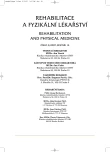-
Medical journals
- Career
Diagnostics of Disorders of Sensor-motor Functions of the Hand in Patients after Ischemic Vascular Event (a Case Study)
Authors: K. Macháčková 1,2; J. Vyskotová 1; J. Opavský 3; H. Sochorová 1
Authors‘ workplace: Katedra rehabilitace, Zdravotně sociální fakulta OU, Ostrava 1; Klinika léčebné rehabilitace, Fakultní nemocnice Ostrava 2; Katedra fyzioterapie, Fakulta tělesné kultury UP, Olomouc 3
Published in: Rehabil. fyz. Lék., 14, 2007, No. 3, pp. 114-121.
Category: Original Papers
Overview
The impairments of sensorimotor hand functions after a stroke have a negative impact on the subject@s interaction with external settings and on performing common daily and working activities and thus on the quality of his or her life.
Since the structure and function of the cerebral cortex is capable of after-stroke modifications, new therapies are being looked for that support the desirable plasticity of the CNS to the maximum.
The main condition for a successful treatment is a reliable target-focused examination of all hand functions affected by the stroke. This requires both a differentiated and complex examination.
This thesis presents the results and experiences of treating patients hospitalized after a stroke. The impaired motor and somatosensoric functions have been assessed through somatosensoric and manipulation tests. In three case studies, the differences are pointed out between the results of the clinical nerological hand exmination and the functional hand examination. Both examinations use target-focused specialized tests.Key words:
stroke, post-stroke hand, sensorimotor functions, hand function tests, neurological examination
Sources
1. CAREY, L. M.: Somatosensory loss after stroke. In Critical Reviews in Physical and Rehabilitation Medicine, 1995, 7, pp. 51-91.
2. MAYER, M.; HLUŠTÍK, P.: Ruka u hemiparetického pacienta. Neurofyziologie, patofyziologie, rehabilitace. Rehabilitácia, 41, 2004, s. 9–13.
3. CARR, J., SHEPHERD, R.: Neurological rehabilitation: Optimizing motor performance. Oxford, Butterworth-Heinemann, 1998.
4. BROTT, T., ADAMS, H. P,; OLINGER, C. P. et al.: Measurements of acute cerebral infarction: A clinical examination scale. Stroke, 20, 1989, pp. 864-870.
5. OPAVSKÝ, J.: Neurologické vyšetření v rehabilitaci pro fyzioterapeuty. Olomouc, Univerzita Palackého v Olomouci, 2003.
6. CAREY, L. M., OKE, L. E., MATYAS, T. A.: Impaired touch discrimination after stroke: a quantitative test. Journal of Neurologic Rehabilitation, 11, 1997, pp. 219-232.
7. WINWARD, H. E., HALLIGANA, P. W., WADE, D. T.: Rivermead Assessement of Somatosensory Performance. Suffolk, Thames Valley Test Company Ltd., 2000.
8. DUNCAN, P. W., WEINER, D. K., CHANDLER, J., STUDENSKI, S. Functional reach: a new clinical measure of balance. Journal of Gerontology, 1990, 45, pp. 195-197.
9. WADE, T. D.: Measurement in neurological rehabilitation. Oxford, Oxford University Press, 1994.
10. MATHIOWETZ, V., WEBER, K., KASHMAN, N., VOLLAND, G.: Adult norms for the nine hole peg test of finger dexterity. The Occupational Therapy Journal of Research, 1985, 5, pp. 24-37.
11. VYSKOTOVÁ, J.,VAVERKA, F. :Test of manipulation abilities as a means of therapy to tackle insufficient hand functions. In F. Vaverka (Ed.), Proceedings of the 3rd International Conference Movement and Health, Olomouc 2003. Olomouc, Univerzita Palackého, 2003, s. 357-360.
12. VYSKOTOVÁ, J.: The use of the special constructional set to diagnose and treat brain functions disorders and those of the hand. Slovenská antropológia. Bulletin Slovenskej antropologickej spoločnosti pri SAV, 2003, 6, s. 190-192.
Labels
Physiotherapist, university degree Rehabilitation Sports medicine
Article was published inRehabilitation & Physical Medicine

2007 Issue 3-
All articles in this issue
- Effects of Rehabilitation in Patients with Disorders of Temporomandibular Joint
- SEMG Activity Monitoring of Selected Muscles in Nordic Walking and Plain Walking
- The Utilization of Electrical Stimulation in Rehabilitation after Radical Prostatectomy
- Diagnostics of Disorders of Sensor-motor Functions of the Hand in Patients after Ischemic Vascular Event (a Case Study)
- The Importance of Lateral Ankle Joint Ligaments
- Rehabilitation & Physical Medicine
- Journal archive
- Current issue
- Online only
- About the journal
Most read in this issue- The Importance of Lateral Ankle Joint Ligaments
- Diagnostics of Disorders of Sensor-motor Functions of the Hand in Patients after Ischemic Vascular Event (a Case Study)
- Effects of Rehabilitation in Patients with Disorders of Temporomandibular Joint
- The Utilization of Electrical Stimulation in Rehabilitation after Radical Prostatectomy
Login#ADS_BOTTOM_SCRIPTS#Forgotten passwordEnter the email address that you registered with. We will send you instructions on how to set a new password.
- Career

